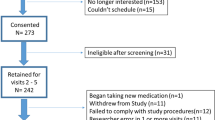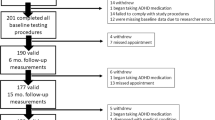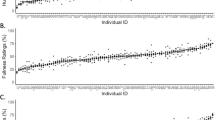Abstract
BACKGROUND:
Food reinforcement is an empirical index of motivation to obtain food. Higher levels of food reinforcement are associated with increased energy intake and increased body weight. Food reinforcement can vary over repeated food presentations, as people may show reduced reinforcing value if they satiate to repeated reinforcers, or they may show sensitization, or an increase in reinforcing value with repeated presentations. Over the past few years, our laboratory has been studying the impact of repeated administration of large portions of high energy density snack foods on food reinforcement. We have shown in three separate studies that the majority of non-obese individuals become satiated after 2 weeks of the same snack food administration, but that a subset of obese individuals sensitize after this same manipulation.
OBJECTIVE:
The purpose of the study presented here was to identify predictors of reinforcer satiation or sensitization.
SUBJECTS:
For the analyses presented here, we combined data sets from three previous studies for a total of 67 adult participants.
RESULTS:
We found that higher body mass index (BMI) and higher baseline motivation to eat predicted sensitization, and baseline motivation to eat moderated the effects of BMI, such that higher baseline responding for food predicted sensitization in obese individuals, but satiation in non-obese individuals.
CONCLUSIONS:
These data suggest that repeated exposure to high energy density snack foods may result in sensitization to those foods, with similar effects as drugs of abuse in susceptible individuals, and that an individual's BMI and baseline responding act as predictors of this response.
This is a preview of subscription content, access via your institution
Access options
Subscribe to this journal
Receive 12 print issues and online access
$259.00 per year
only $21.58 per issue
Buy this article
- Purchase on Springer Link
- Instant access to full article PDF
Prices may be subject to local taxes which are calculated during checkout

Similar content being viewed by others
References
Bickel WK, Marsch LA, Carroll ME . Deconstructing relative reinforcing efficacy and situating the measures of pharmacological reinforcement with behavioral economics: a theoretical proposal. Psychopharmacology 2000; 153: 44–56.
Epstein LH, Wright SM, Paluch RA, Leddy J, Hawk Jr LW, Jaroni JL et al. Food hedonics and reinforcement as determinants of laboratory food intake in smokers. Physiol Behav 2004; 81: 511–517.
Epstein LH, Wright SM, Paluch RA, Leddy JJ, Hawk Jr LW, Jaroni JL et al. Relation between food reinforcement and dopamine genotypes and its effect on food intake in smokers. Am J Clin Nutr 2004; 80: 82–88.
Saelens BE, Epstein LH . Reinforcing value of food in obese and non-obese women. Appetite 1996; 27: 41–50.
Temple JL, Legierski CM, Giacomelli AM, Salvy SJ, Epstein LH . Overweight children find food more reinforcing and consume more energy than do nonoverweight children. Am J Clin Nutr 2008; 87: 1121–1127.
Epstein LH, Saad FG, Handley EA, Roemmich JN, Hawk LW, McSweeney FK . Habituation of salivation and motivated responding for food in children. Appetite 2003; 41: 283–289.
Myers Ernst M, Epstein LH . Habituation of responding for food in humans. Appetite 2002; 38: 224–234.
Raynor HA, Epstein LH . The relative-reinforcing value of food under differing levels of food deprivation and restriction. Appetite 2003; 40: 15–24.
Temple JL, Giacomelli AM, Roemmich JN, Epstein LH . Dietary variety impairs habituation in children. Health Psychol 2008; 27: S10–S19.
Lappalainen R, Epstein LH . A behavioral economics analysis of food choice in humans. Appetite 1990; 14: 81–93.
Goldfield GS, Epstein LH . Can fruits and vegetables and activities substitute for snack foods? Health Psychol 2002; 21: 299–303.
Clark EN, Dewey AM, Temple JL . Effects of daily snack food intake on food reinforcement depend on body mass index and energy density. Am J Clin Nutr 2010; 91: 300–308.
Temple JL, Bulkley AM, Badawy RL, Krause N, McCann S, Epstein LH . Differential effects of daily snack food intake on the reinforcing value of food in obese and nonobese women. Am J Clin Nutr 2009; 90: 304–313.
Temple JL, Chappel A, Shalik J, Volcy S, Epstein LH . Daily consumption of individual snack foods decreases their reinforcing value. Eat Behav 2008; 9: 267–276.
Robinson TE, Berridge KC . The neural basis of drug craving: an incentive-sensitization theory of addiction. Brain Res 1993; 18: 247–291.
Hobbs M, Remington B, Glautier S . Dissociation of wanting and liking for alcohol in humans: a test of the incentive-sensitisation theory. Psychopharmacology (Berl) 2005; 178: 493–499.
Ostafin BD, Marlatt GA, Troop-Gordon W . Testing the incentive-sensitization theory with at-risk drinkers: wanting, liking, and alcohol consumption. Psychol Addict Behav 2010; 24: 157–162.
Robinson TE, Berridge KC . Review. The incentive sensitization theory of addiction: some current issues. Philos Trans R Soc Lond 2008; 363: 3137–3146.
Keiflin R, Isingrini E, Cador M . Cocaine-induced reinstatement in rats: evidence for a critical role of cocaine stimulus properties. Psychopharmacology (Berl) 2008; 197: 649–660.
Keiflin R, Vouillac C, Cador M . Level of operant training rather than cocaine intake predicts level of reinstatement. Psychopharmacology (Berl) 2008; 197: 247–261.
Robinson TE, Berridge KC . Incentive-sensitization and addiction. Addiction (Abingdon, England) 2001; 96: 103–114.
Spitzer RL, Yanovski S, Wadden T, Wing R, Marcus MD, Stunkard A et al. Binge eating disorder: its further validation in a multisite study. Int J Eat Disord 1993; 13: 137–153.
Gormally J, Black S, Daston S, Rardin D . The assessment of binge eating severity among obese persons. Addict Behav 1982; 7: 47–55.
Reiss S, Havercamp S . The sensitivity theory of motivation: implications for psychopathology. Behav Res Ther 1996; 34: 621–632.
Epstein LH, Temple JL, Neaderhiser BJ, Salis R, Leddy JJ . Food reinforcement, the dopamine D2 receptor genotype, and energy intake in obese and non-obese humans. Behav Neurosci 2007; 121: 877–886.
Casey PH, Goolsby SL, Lensing SY, Perloff BP, Bogle ML . The use of telephone interview methodology to obtain 24-hour dietary recalls. J Am Diet Assoc 1999; 99: 1406–1411.
Tran KM, Johnson RK, Soultanakis RP, Matthews DE . In-person vs telephone-administered multiple-pass 24-hour recalls in women: validation with doubly labeled water. J Am Diet Assoc 2000; 100: 777–783.
NHLBI Obesity Education Initiative Expert Panel. Clinical Guidelines on the identification, evaluation, and treatment of overweight and obesity in adults–The evidence report. Obes Res 1998; 6 (Suppl 2): 51S–209S.
Stunkard AJ, Messick S . The three-factor eating questionnaire to measure dietary restraint, disinhibition and hunger. J Psychosom Res 1985; 29: 71–83.
Epstein LH, Truesdale R, Wojcik A, Paluch RA, Raynor HA . Effects of deprivation on hedonics and reinforcing value of food. Physiol Behav 2003; 78: 221–227.
Epstein LH, Temple JL, Neaderhiser BJ, Salis RJ, Erbe RW, Leddy JJ . Food reinforcement, the dopamine D2 receptor genotype, and energy intake in obese and nonobese humans. Behav Neurosci 2007; 121: 877–886.
Podlesnik CA, Shahan TA . Reinforcer satiation and resistance to change of responding maintained by qualitatively different reinforcers. Behav Processes 2009; 81: 126–132.
Hetherington MM, Bell A, Rolls BJ . Effects of repeated consumption on pleasantness, preference, and intake. Br Food J 2000; 102: 507–521.
Hetherington MM, Foster R, Newman T, Anderson AS, Norton G . Understanding variety: tasting different foods delays satiation. Physiol Behav 2006; 87: 263–271.
Hetherington MM, Pirie LM, Nabb S . Stimulus satiation: effects of repeated exposure to foods on pleasantness and intake. Appetite 2002; 38: 19–28.
Raynor HA, Epstein LH . Dietary variety, energy regulation, and obesity. Psychol Bull 2001; 127: 325–341.
Hill C, Saxton J, Webber L, Blundell J, Wardle J . The relative reinforcing value of food predicts weight gain in a longitudinal study of 7–10-y-old children. Am J Clin Nutr 2009; 90: 276–281.
Carelli RM . Nucleus accumbens cell firing and rapid dopamine signaling during goal-directed behaviors in rats. Neuropharmacology 2004; 47 (Suppl 1): 180–189.
Acknowledgements
This work was supported by start-up funds to JLT. We thank Erika Clark and Amber Dewey for assistance with data collection.
Author information
Authors and Affiliations
Corresponding author
Ethics declarations
Competing interests
LHE is a consultant for Kraft foods. JLT declares no conflict of interest.
Rights and permissions
About this article
Cite this article
Temple, J., Epstein, L. Sensitization of food reinforcement is related to weight status and baseline food reinforcement. Int J Obes 36, 1102–1107 (2012). https://doi.org/10.1038/ijo.2011.210
Received:
Revised:
Accepted:
Published:
Issue Date:
DOI: https://doi.org/10.1038/ijo.2011.210
Keywords
This article is cited by
-
Sensitization of the reinforcing value of food: a novel risk factor for overweight in adolescents
International Journal of Obesity (2020)
-
Factors influencing the reinforcing value of fruit and unhealthy snacks
European Journal of Nutrition (2017)



